German actress and singer Else Elster (1910-1998) appeared in over forty films during the Weimar and Nazi eras.
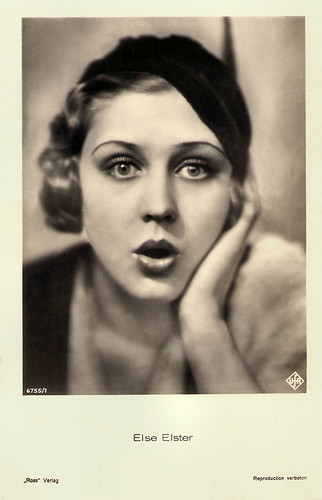
German postcard by Ross Verlag, no. 6755/1, 1931-1932. Photo: Ufa.

German postcard by Ross Verlag, no. 6742/1, 1931-1932. Photo: Ufa. Publicity still for Der Frechdachs/The Cheeky Devil (Carl Boese, Heinz Hille, 1932) with Willy Fritsch.
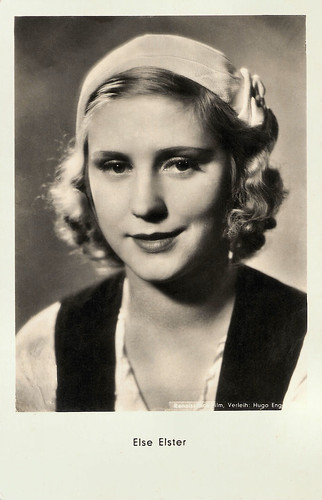
Austrian postcard by Iris Verlag, no. 6690. Photo: Renaissance Film / Verleih: Hugo Engel. Publicity still for Flucht nach Nizza/Escape to Nice (James Bauer, 1933).
Else Elster was born in 1910 (some sources say 1912) in Danzig, Germany (now Gdansk, Poland). She was trained by actress Ilka Grüning in Berlin and attended the Musikhochschule (music academy) in Vienna. Already before her exams, she made her film debut in the musical Die blonde Nachtigall/The Blonde Nightingale (Johannes Meyer, 1930) as the daughter of Gustav Schubert (Ernst Behmer).
Despite starring in her film debut, she was primarily used as a second lead and supporting player in her next films like the hilarious comedy Der Herr auf Bestellung/Gentleman for Hire (Géza von Bolváry, 1930), the operetta Viktoria und ihr Husar/Victoria and Her Hussar (Richard Oswald, 1931) and the musical comedy Wochenend im Paradies/Weekend in Paradise (Robert Land, 1931) with Otto Wallburg and Claire Rommer.
The year 1932 was a very busy one for Else Elster. She took part in eight films, including Geheimnis des blauen Zimmers/The Secret of the Blue Room (Erich Engels, 1932), the comedy Der Frechdachs/The Cheeky Devil (Carl Boese, Heinz Hille, 1932) starring Willy Fritsch, and the thriller Tod über Shanghai/Death Over Shanghai (Rolf Randolf, 1932) starring Gerda Maurus.
The Chinese Ministry of Education requested that the German government have Tod über Shanghai/Death Over Shanghai (Rolf Randolf, 1932) destroyed because they had received reports that it "ridiculed China and the Chinese people". That year, Elster also made her theatre debut and in the following years, she impersonated many roles on stage. Like many other young actresses in the Third Reich, she was one of the celebrities with whom Adolf Hitler liked to show himself. She was one of the first TV announcers of the television station Paul Nipkow.
Her later films included the comedy Muß man sich gleich scheiden lassen/Must We Get Divorced? (Hans Behrendt, 1933) with Aribert Mog and Iván Petrovich, the romantic comedy Krach im Hinterhaus/Trouble Backstairs (Veit Harlan, 1935) starring Henny Porten, and the historical romance Drei Mäderl um Schubert/Three Girls for Schubert (E.W. Emo, 1936) with Paul Hörbiger as composer Franz Schubert.
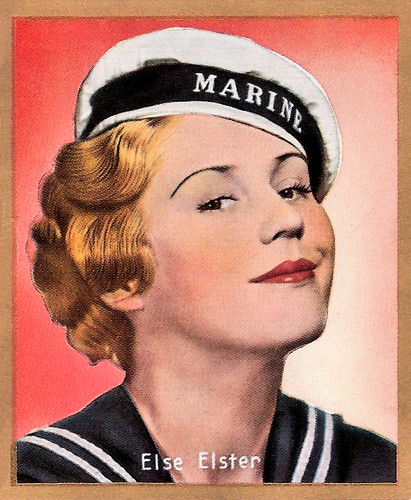
German cigarette card in the series Unsere Bunten Filmbilder by Ross Verlag for Cigarettenfabrik Josetti, Berlin, no. 153. Photo: Alex Binder.
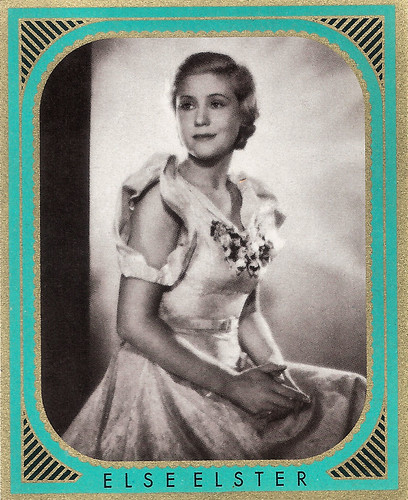
German collectors card in the Bunte Filmbilder series by Caid Zigaretten, Series no. 2, no. 323. Photo: Schulz and Wuellner / Ross-Verlag.
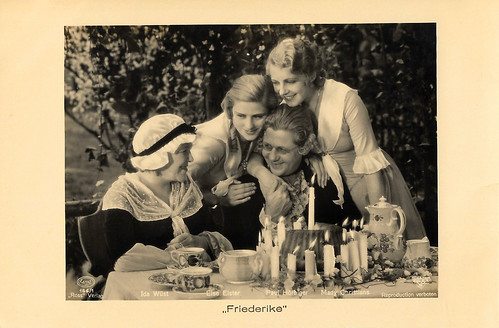
German postcard by Ross Verlag no. 166/1. Photo: Indra-Film / Rolf Raffé. Ida Wüst, Else Elster, Paul Hörbiger and Mady Christians in Friederike/Frederica (Fritz Friedmann-Frederich, 1932).
During the Second World War, Else Elster entered into a relationship with the Berlin police chief Wolf Heinrich Graf von Helldorf, who had joined the Stauffenberg group. Personal family records show that Elster marked the date of her lover's execution (15 August 1944) with a cross in her diary.
The farewell letter of Count Helldorf is still owned by the family and can be seen as a copy in the House of Resistance in Berlin. Already weeks before the execution she had to appear again and again for nightly Gestapo interrogations. In fact, she did not know anything about Count Helldorf's resistance plans.
Elster was pregnant by Helldorf and their daughter later was named Christa. After the war, Else Elster's filmmaking was practically over because of her close association with the Nazi regime and especially with Propaganda Minister Joseph Goebbels and also because her role in the notorious Nazi propaganda film Jud Süß (Veit Harlan, 1940) as the mistress of the title figure. She only appeared in one more film, Nichts als Zufälle/Nothing but Coincidences (E.W. Emo, 1949) starring Theo Lingen. Nevertheless, she continued to work as a stage actress, cabaret artist and singer, but without her former success.
Later she married the gynecologist Dr. Erhard Schlaegel and moved in with him in his villa in Günzburg. Her husband brought two children into the marriage and in 1950, Else Schlaegel gave birth to her son Wolf Wilhelm Schlaegel. Together with her husband, she worked for the next few years in the gynaecological clinic.
In 1996, Erhard Schlaegel died shortly after the birth of his grandchild. Else Schlaegel lived for another two years in an apartment in Günzburg, before she died in 1998. Both spouses are buried in the family grave of the family Schlaegel in the Günzburger cemetery. Her son Wolf Wilhelm Schlaegel became a rehabilitation specialist and now lives with his family in his parents' home in Günzburg. He granted the museum House of Resistance in Berlin an insight into his mother's personal files.
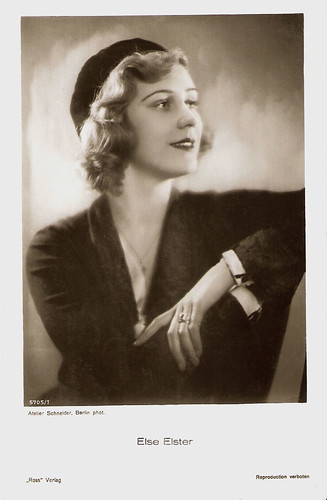
German postcard by Ross Verlag, no. 5705/1, 1930-1931. Photo: Atelier Schneider.
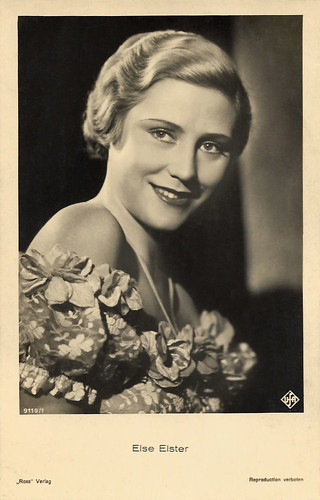
German postcard by Ross Verlag, no. 9119/1, 1935-1936. Photo: UFA.
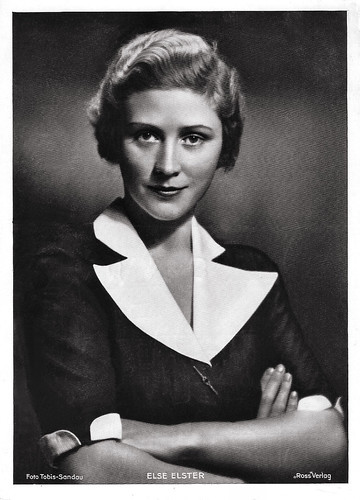
Big German card by Ross Verlag. Photo: Tobis / Sandau.
Sources: Stephanie D'heil (Steffi-Line.de – German), Wikipedia (German and English), and IMDb.
This post was last updated on 17 February 2024.

German postcard by Ross Verlag, no. 6755/1, 1931-1932. Photo: Ufa.

German postcard by Ross Verlag, no. 6742/1, 1931-1932. Photo: Ufa. Publicity still for Der Frechdachs/The Cheeky Devil (Carl Boese, Heinz Hille, 1932) with Willy Fritsch.

Austrian postcard by Iris Verlag, no. 6690. Photo: Renaissance Film / Verleih: Hugo Engel. Publicity still for Flucht nach Nizza/Escape to Nice (James Bauer, 1933).
Ridiculing China and the Chinese people
Else Elster was born in 1910 (some sources say 1912) in Danzig, Germany (now Gdansk, Poland). She was trained by actress Ilka Grüning in Berlin and attended the Musikhochschule (music academy) in Vienna. Already before her exams, she made her film debut in the musical Die blonde Nachtigall/The Blonde Nightingale (Johannes Meyer, 1930) as the daughter of Gustav Schubert (Ernst Behmer).
Despite starring in her film debut, she was primarily used as a second lead and supporting player in her next films like the hilarious comedy Der Herr auf Bestellung/Gentleman for Hire (Géza von Bolváry, 1930), the operetta Viktoria und ihr Husar/Victoria and Her Hussar (Richard Oswald, 1931) and the musical comedy Wochenend im Paradies/Weekend in Paradise (Robert Land, 1931) with Otto Wallburg and Claire Rommer.
The year 1932 was a very busy one for Else Elster. She took part in eight films, including Geheimnis des blauen Zimmers/The Secret of the Blue Room (Erich Engels, 1932), the comedy Der Frechdachs/The Cheeky Devil (Carl Boese, Heinz Hille, 1932) starring Willy Fritsch, and the thriller Tod über Shanghai/Death Over Shanghai (Rolf Randolf, 1932) starring Gerda Maurus.
The Chinese Ministry of Education requested that the German government have Tod über Shanghai/Death Over Shanghai (Rolf Randolf, 1932) destroyed because they had received reports that it "ridiculed China and the Chinese people". That year, Elster also made her theatre debut and in the following years, she impersonated many roles on stage. Like many other young actresses in the Third Reich, she was one of the celebrities with whom Adolf Hitler liked to show himself. She was one of the first TV announcers of the television station Paul Nipkow.
Her later films included the comedy Muß man sich gleich scheiden lassen/Must We Get Divorced? (Hans Behrendt, 1933) with Aribert Mog and Iván Petrovich, the romantic comedy Krach im Hinterhaus/Trouble Backstairs (Veit Harlan, 1935) starring Henny Porten, and the historical romance Drei Mäderl um Schubert/Three Girls for Schubert (E.W. Emo, 1936) with Paul Hörbiger as composer Franz Schubert.

German cigarette card in the series Unsere Bunten Filmbilder by Ross Verlag for Cigarettenfabrik Josetti, Berlin, no. 153. Photo: Alex Binder.

German collectors card in the Bunte Filmbilder series by Caid Zigaretten, Series no. 2, no. 323. Photo: Schulz and Wuellner / Ross-Verlag.

German postcard by Ross Verlag no. 166/1. Photo: Indra-Film / Rolf Raffé. Ida Wüst, Else Elster, Paul Hörbiger and Mady Christians in Friederike/Frederica (Fritz Friedmann-Frederich, 1932).
Her lover's execution
During the Second World War, Else Elster entered into a relationship with the Berlin police chief Wolf Heinrich Graf von Helldorf, who had joined the Stauffenberg group. Personal family records show that Elster marked the date of her lover's execution (15 August 1944) with a cross in her diary.
The farewell letter of Count Helldorf is still owned by the family and can be seen as a copy in the House of Resistance in Berlin. Already weeks before the execution she had to appear again and again for nightly Gestapo interrogations. In fact, she did not know anything about Count Helldorf's resistance plans.
Elster was pregnant by Helldorf and their daughter later was named Christa. After the war, Else Elster's filmmaking was practically over because of her close association with the Nazi regime and especially with Propaganda Minister Joseph Goebbels and also because her role in the notorious Nazi propaganda film Jud Süß (Veit Harlan, 1940) as the mistress of the title figure. She only appeared in one more film, Nichts als Zufälle/Nothing but Coincidences (E.W. Emo, 1949) starring Theo Lingen. Nevertheless, she continued to work as a stage actress, cabaret artist and singer, but without her former success.
Later she married the gynecologist Dr. Erhard Schlaegel and moved in with him in his villa in Günzburg. Her husband brought two children into the marriage and in 1950, Else Schlaegel gave birth to her son Wolf Wilhelm Schlaegel. Together with her husband, she worked for the next few years in the gynaecological clinic.
In 1996, Erhard Schlaegel died shortly after the birth of his grandchild. Else Schlaegel lived for another two years in an apartment in Günzburg, before she died in 1998. Both spouses are buried in the family grave of the family Schlaegel in the Günzburger cemetery. Her son Wolf Wilhelm Schlaegel became a rehabilitation specialist and now lives with his family in his parents' home in Günzburg. He granted the museum House of Resistance in Berlin an insight into his mother's personal files.

German postcard by Ross Verlag, no. 5705/1, 1930-1931. Photo: Atelier Schneider.

German postcard by Ross Verlag, no. 9119/1, 1935-1936. Photo: UFA.

Big German card by Ross Verlag. Photo: Tobis / Sandau.
Sources: Stephanie D'heil (Steffi-Line.de – German), Wikipedia (German and English), and IMDb.
This post was last updated on 17 February 2024.
No comments:
Post a Comment